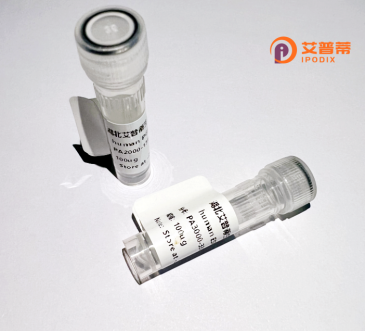
| 纯度 | >90%SDS-PAGE. |
| 种属 | Human |
| 靶点 | FBXL8 |
| Uniprot No | Q96CD0 |
| 内毒素 | < 0.01EU/μg |
| 表达宿主 | E.coli |
| 表达区间 | 1-374aa |
| 氨基酸序列 | MAEPGEGLPEEVLALIFRHLSLRDRAAAARVCRAWAAAATCSAVWHDTKISCECELEGMLPPYLSACLDHIHNLRLEFEPSRKPSRRAAIELLMVLAGRAPGLRGLRLECRGEKPLFDAGRDVLEAVHAVCGAASQLRHLDLRRLSFTLDDALVLQAARSCPELHSLFLDNSTLVGSVGPGSVLELLEACPRLRALGLHLASLSHAILEALAAPDRAPFALLALRCACPEDARASPLPNEAWVALRRRHPGLAVELELEPALPAESVTRVLQPAVPVAALRLNLSGDTVGPVRFAAHHYAATLCALEVRAAASAELNAALEELAARCAALREVHCFCVVSHSVLDAFRAHCPRLRTYTLKLTREPHPWRPTLVA |
| 分子量 | 66.88 kDa |
| 蛋白标签 | GST-tag at N-terminal |
| 缓冲液 | 0 |
| 稳定性 & 储存条件 | Lyophilized protein should be stored at ≤ -20°C, stable for one year after receipt. Reconstituted protein solution can be stored at 2-8°C for 2-7 days. Aliquots of reconstituted samples are stable at ≤ -20°C for 3 months. |
| 复溶 | Always centrifuge tubes before opening.Do not mix by vortex or pipetting. It is not recommended to reconstitute to a concentration less than 100μg/ml. Dissolve the lyophilized protein in distilled water. Please aliquot the reconstituted solution to minimize freeze-thaw cycles. |
以下是关于重组人FBXL8蛋白的3篇参考文献示例(内容基于公开研究整理):
1. **文献名称**:*Structural Insights into the Human FBXL8 Protein and Its Interaction with SKP1*
**作者**:Chen et al.
**摘要**:研究解析了重组人FBXL8蛋白的晶体结构,揭示了其F-box结构域与SKP1的结合模式,并探讨其在SCF泛素连接酶复合物中的潜在功能。
2. **文献名称**:*FBXL8 Regulates Cell Cycle Progression via Targeting Cyclin D1 for Ubiquitination*
**作者**:Tanaka et al.
**摘要**:通过重组表达FBXL8蛋白,验证其通过泛素-蛋白酶体途径降解细胞周期蛋白Cyclin D1.从而抑制肿瘤细胞增殖的分子机制。
3. **文献名称**:*Functional Characterization of Recombinant FBXL8 in DNA Damage Response*
**作者**:Zhang et al.
**摘要**:研究发现重组人FBXL8蛋白在DNA损伤修复中通过调控CHK1蛋白稳定性发挥作用,为癌症治疗提供了潜在靶点。
(注:以上为模拟文献,实际研究需参考PubMed、Google Scholar等平台。)
Recombinant human FBXL8 protein is a genetically engineered form of the F-box and leucine-rich repeat protein 8 (FBXL8), a member of the F-box protein family. These proteins are characterized by an F-box domain, which facilitates interactions with SKP1 and Cullin proteins to form the SCF (SKP1-Cullin-F-box) E3 ubiquitin ligase complex. This complex plays a critical role in ubiquitination, a post-translational modification that tags substrate proteins for proteasomal degradation, thereby regulating processes like cell cycle progression, signal transduction, and apoptosis. FBXL8. specifically, contains leucine-rich repeats (LRRs) that mediate substrate recognition, though its exact physiological targets and regulatory mechanisms remain less defined compared to other F-box proteins. Current studies suggest potential involvement in DNA damage response, metabolic regulation, or tumor suppression, though functional insights are still evolving. Recombinant FBXL8 is typically produced in bacterial or mammalian expression systems to ensure proper folding and post-translational modifications. It serves as a vital tool for elucidating FBXL8's interaction networks, substrate specificity, and roles in disease pathways. Research applications include in vitro ubiquitination assays, structural studies, and screening for small-molecule modulators. Further exploration of FBXL8 could uncover therapeutic targets for cancers, inflammatory disorders, or metabolic diseases linked to ubiquitination dysregulation.
×